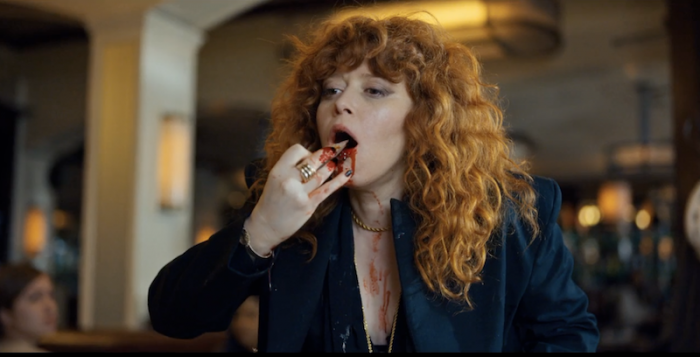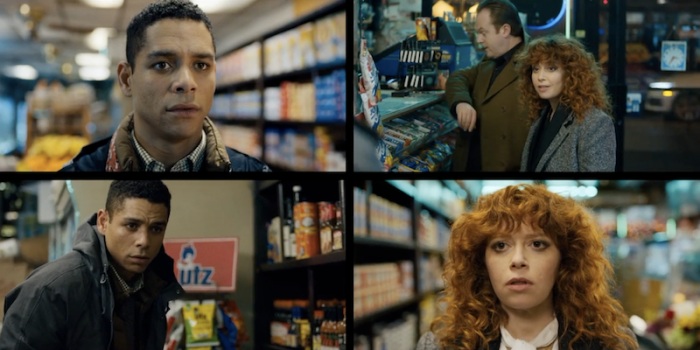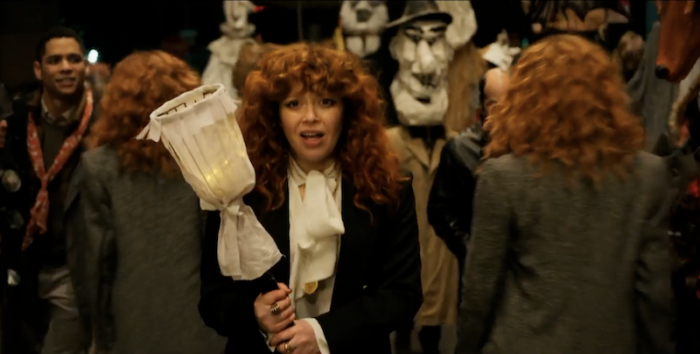Let's Talk About The Ending Of Netflix's 'Russian Doll'
Netflix's Russian Doll really surprised me. At first I thought it was just a warmed over Groundhog Day rehash with characters that I wasn't really a fan of, but episodes three and four throw into focus the true arc of the series. From that point on, I was hooked and couldn't stop until I got to the end.
Let's discuss the themes of Russian Doll and try to interpret that crazy ending. You can also check out my video review of the series below. Naturally, major spoilers for Russian Doll season 1 follow.
Russian Doll Ending Explained
Russian Doll is about a woman named Nadia Vulvakov (Natasha Lyonne) who's attending her 36th birthday party but then dies, only to find herself back at the party and forced to repeat this time period in her life over and over again. Along the way, she meets Alan (Charlie Barnett), another person who is trapped in the same predicament. Together, they have to unravel the mystery of what is happening to them, and maybe learn some life lessons along the way.
While Russian Doll is ostensibly about a mysterious force that causes the day to repeat, for Nadia, that force is really a metaphor for trauma and what it takes to come to terms with it. A Russian doll is a doll that has numerous smaller instances of itself within it. And just like a Russian doll, Nadia has a smaller version of herself inside of her. It's the child version of her that experienced trauma when she was young, seeing her mother smash mirrors in a fit of pique and then becoming wracked with guilt at her mother's death. It's the part of herself that keeps reliving this incident over and over again, being unable to move on, and then being forced to watch as this trauma wreaks havoc on her personal life and her relationships.
It's no coincidence that Nadia's surrogate mother Ruth (Elizabeth Ashley) is an EMDR therapist. EMDR stands for Eye Movement Desensitization and Reprocessing, and according to the EMDR International Association website:
When a person is very upset, their brain cannot process information as it does ordinarily. One moment becomes "frozen in time," and remembering a trauma may feel as bad as going through it the first time because the images, sounds, smells, and feelings haven't changed. Such memories have a lasting negative effect that interferes with the way a person sees the world and the way they relate to other people [...]
Following a successful EMDR session, a person no longer relives the images, sounds, and feelings when the event is brought to mind. You still remember what happened, but it is less upsetting. EMDR can be thought of as a physiologically based therapy that helps a person see disturbing material in a new and less distressing way.
If we take this into account, then the show itself becomes a metaphor for therapy: re-exploring a singular event over and over and understanding how to handle it so that one can move past it. This is most clear at the cafe scene, which shows that the younger version of Nadia is still inside her and has the potential to kill her, with that piece of the mirror being the physical manifestation of trauma.
While Nadia is making her realization about why she's being forced to repeat the day, she meets a man named Alan who's doing the same thing. But Alan's day is not about trauma. It's about coming to terms with his own selfishness and insensitivity.
One of the great things about the show is how it draws a stark contrast between Alan and Nadia. Their personalities are different, as is how they approach the day: Nadia tries to branch out into increasingly diverse choices, while Alan willingly re-lives the day, even though it's terrible. These differences even are manifested in the way they dress and how their apartments look.
In an interview with Vulture, Michael Bricker, Russian Doll's production designer, talked about these differences:
When Nadia meets Alan, who is also stuck in a time loop, his world is designed to look like the inverse of hers: "Where she's dark, he's light. Where she's brown, he's fair. Where she has tertiary colors, he has more primary colors." Then, as Nadia and Alan's lives bleed into each other, their worlds change. "His world becomes messier. Hers becomes a little bit cleaner."
Gradually, both Nadia and Alan realize what they need to do to escape the day. They need to reconcile with the people in their lives, come to a deeper understanding of themselves and their own flaws, and then try to get back to the first time loop and help the other person in a time of need. They need to decline to be self-absorbed enough to change a life, maybe even to save a life.
So they do all that, only when they go back, they realize they are in separate timelines. The Nadia that remembers everything encounters a drunk Alan, while the Alan that remembers everything encounters a Nadia who's ready to go home with serial philanderer Mike (Jeremy Lowell Bobb).
You see that the Nadia that remembers the day – let's call her Nadia A – she's wearing a grey coat with a white shirt. While the new Nadia, the Nadia that Alan needs to prove he knows by quoting an extremely specific dollar amount ($152,780.86), that Nadia is wearing a gray coat with a black shirt (let's call her Nadia B). However, as they both come to an understanding of each other and reunite, this time as friends, both pairs of Nadias and Alans join a huge parade in progress.
We see them from behind, with Nadia A on the Left and Nadia B on the Right. Then, just as they're about to emerge from the tunnel, we cut to a reverse shot with Nadia A, and then TWO Nadias pass her going by.
Whoa, what's going on here? In an interview that Polygon's Karen Han did with co-creator Leslye Headland, Headland talks about what exactly is happening with this ending, saying, in part:
"I love when Fellini's films end that way, like in 8½ where they're all at the carnival, or La Dolce Vita when they all walk into the woods [...] It reminds me of almost a curtain call, in the sense of it's kind of going like, 'Hey, this was a thing we made!' We're not necessarily trying to totally break the fourth wall, but kind of going, 'Let's celebrate the fact that it's over now!' So when those two Nadias go by her at the end, hopefully you, again, get that feeling of completion and narrative satisfaction. But then also that kind of question mark of, 'Is it ever really the end? Do these things ever really stop?'"
So on a very basic level, I think the ending of the two Nadias passing Nadia A is symbolic. It's not really taking place in any of the timelines. It's like Fellini's ending of 8 1/2, which I don't think really takes place in reality of that film. It's a joyous celebration of all that has come before, everything these characters have gone through and how they've grown. How they all – and by extension, how WE all – need each other, depend on each other, and make each other better. (Or, maybe it's a third, completely different timeline that has been created as a result of all the events of the series. Who knows! Maybe we'll find out in Season 2.)
But in all seriousness, I do think the real ending is symbolic, and that ultimately, all of the characters have found some kind of peace. It's an extremely hopeful ending that left me deeply moved. What did you think of the ending and those final shots? What themes did I miss? Let me know in the comments.
[Special thanks to /Filmcast listener Lawson from Chicago, whose email to me about Russian Doll sent me down this rabbit hole.]



